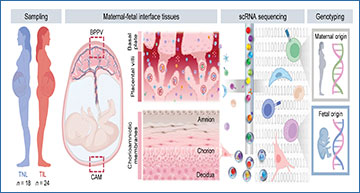An atlas revealing the activity of individual placental cells during childbirth offers insight on what happens at the maternal-fetal interface during term labor, according to a study supported by the National Institutes of Health (NIH). The atlas provides a single-cell analysis of the human placenta and its surrounding membranes and is the first to use this method to understand the communication that occurs between maternal and fetal cells during the process of labor. Studying these processes aids understanding of typical labor and delivery at term, as well as preterm labor and delivery, which occurs before 37 weeks of pregnancy and is a leading cause of infant death and long-term disability. The work, led by researchers at NIH’s Eunice Kennedy Shriver National Institute of Child Health and Human Development (NICHD), is published in the latest issue of Science Translational Medicine.
The study team created the placental atlas by using single-cell RNA sequencing (also called single-cell transcriptomics), which examines the activity and signaling patterns of individual cells. The atlas, which is based on samples from 42 term pregnancies, describes changes in gene expression patterns among the different cell types in the placenta and its surrounding membranes, which include both maternal and fetal-derived cells.
The researchers found that cells most affected by labor were in the chorioamniotic membranes, which surround the fetus and rupture as part of the labor and delivery process. They also found that fetal stromal and maternal decidual cells were particularly active in generating inflammatory signaling. These findings are consistent with previous research showing that inflammation (unrelated to infection) is important for sustaining labor.
The study is also a proof-of-concept that placental biomarkers present in maternal blood may be used to identify pregnancies at risk for preterm birth. The researchers used the atlas to classify cell-specific signatures of labor, which were detectable in maternal blood samples from term and preterm pregnancies. However, additional validation is needed in larger studies.
Source – NIH
Garcia-Flores V, Romero R, Tarca AL, Peyvandipour A, Xu Y, Galaz J, Miller D, Chaiworapongsa T, Chaemsaithong P, Berry SM, Awonuga AO, Bryant DR, Pique-Regi R, Gomez-Lopez N. (2024) Deciphering maternal-fetal cross-talk in the human placenta during parturition using single-cell RNA sequencing. Sci Transl Med 16(729):eadh8335. [abstract]





